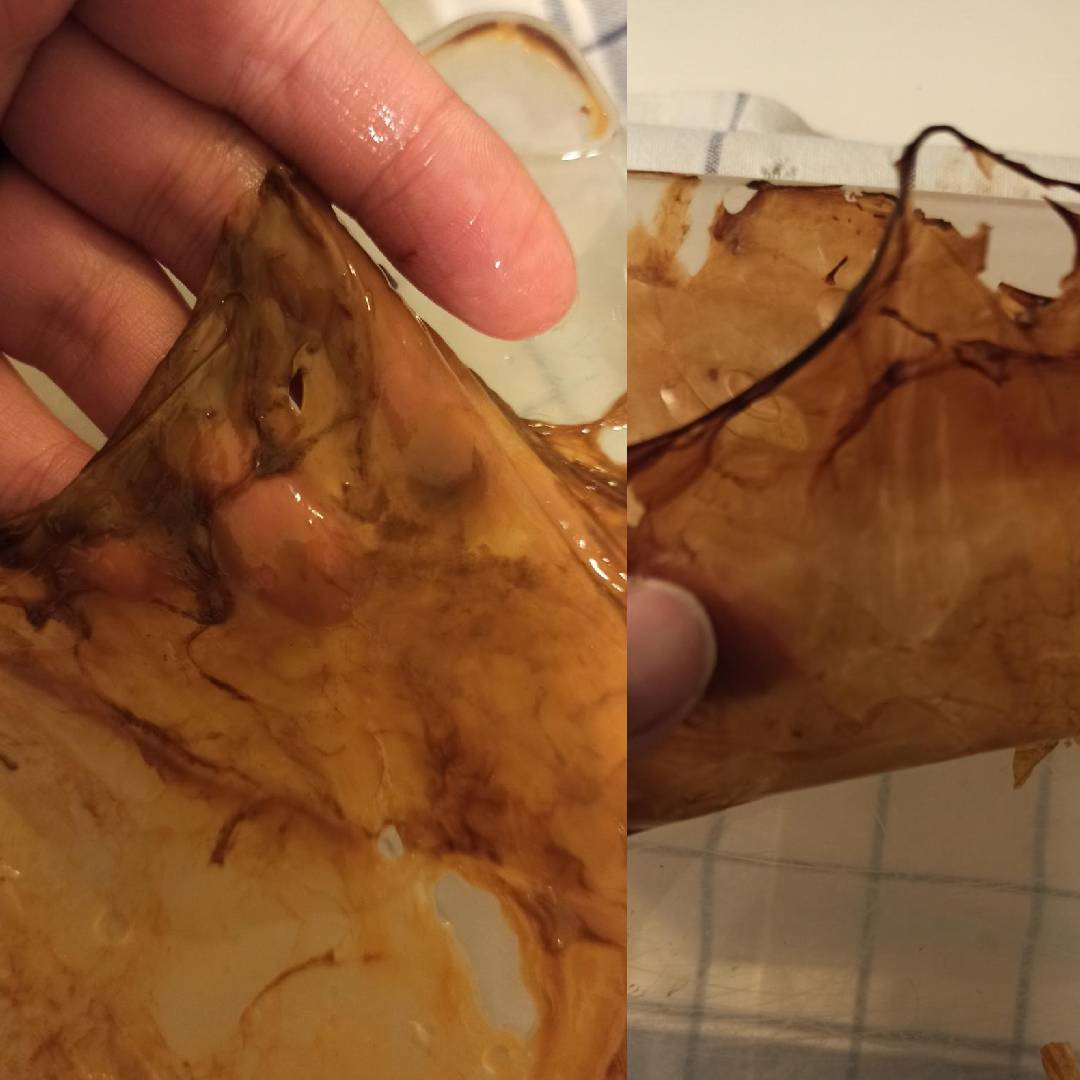6. BioFabricating Materials¶
🗓️ 2023_October 24th to 30th
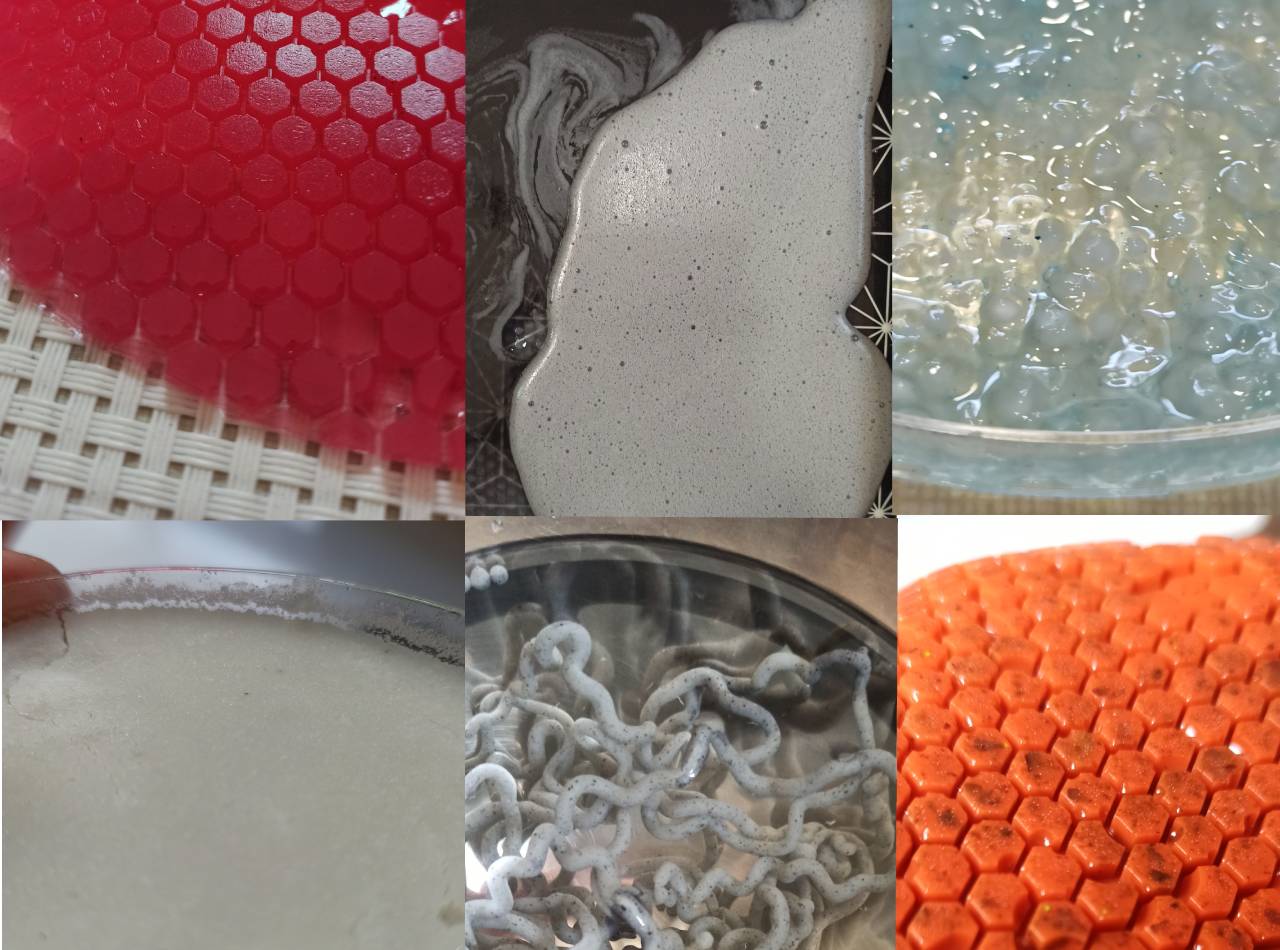
This week's tests, from left to right and top to the bottom: Agar Agar bioplastic, Gelatin silicon, Tapioca bioplastic, Casein test, Alginate thread, Gelatin sheet
Research¶
Just a few years ago, the massive use of plastic in our lifestyles was not considered a social or environmental problem.
More and more actions are being taken these days, but with little impact on a large scale. Alternatives are being sought to reduce our consumption and our impact on the environment.
Bioplastics are a type of plastic material that is derived from renewable resources, such as plants, and can also be made from agricultural byproducts. Unlike traditional plastics, which are typically derived from petrochemicals, bioplastics are considered more environmentally friendly because they can be biodegradable, compostable, and have a reduced carbon footprint.
For this time I asked ChatGPT to answer the following question:
What do bioplastics represent?
1. Renewable Sources: Bioplastics are made from organic materials like corn starch, sugarcane, potato starch, and other agricultural products. This makes them a more sustainable alternative to conventional plastics, which rely on fossil fuels.
2. Biodegradability: Some bioplastics are designed to break down naturally in the environment, reducing their impact on ecosystems. However, it's important to note that not all bioplastics are biodegradable; some are designed to be durable, similar to traditional plastics.
3. Compostability: Certain bioplastics are compostable, meaning they can be broken down in industrial composting facilities under controlled conditions. This helps divert them from landfills and reduces waste.
4.Reduced Carbon Footprint: The production of bioplastics often results in lower greenhouse gas emissions compared to conventional plastics, as they rely on renewable resources and can be manufactured with more energy-efficient processes.
5.Applications: Bioplastics can be used in various applications, including packaging, food containers, agricultural films, and even in the automotive and textile industries. They can be engineered to have different properties to suit specific needs.
I think it's important to distinguish between biodegradable, compostable, and durable bioplastics, as they serve different purposes and have different environmental impacts. Bioplastics are part of ongoing efforts to reduce the environmental impact of plastic materials and promote sustainability in various industries. However, the adoption of bioplastics still faces challenges related to cost, scalability, and waste management infrastructure.
Just like the research carried out in 2016 by Icelandic student Ari Jonsson with his biodegradable bottles made from algae.
I wondered about the durability, quality and production of bio-plastic and biofabricating materials in fashion. Which makes me think about the wear and tear of the clothes we put on, the way they're maintained, stored away, or simply never worn...
alumni's work who inspired me
- Marieke van Eyndhoven TextileLab Amsterdam 2022-23
- Alessia Pasquini TextileLab Amsterdam 2022-23
- Dinesh KumarFabTextiles Barcelona 2022-23
- Diane Wakim Le Textile Lab Lyon 2020-21
- Lucrecia Strano FabTextiles Barcelona 2018-19
- Loes Bogers TextileLab Amsterdam 2019-20
- Beatriz Sandini TextileLab Amsterdam 2019-20
- Olatz Pereda Basque Design Center 2021-22
References & Inspiration¶
Cecilia's lecture of this week was as intestering as ever.
I found many interestings works and ideas on Future Materials Bank, including work of Zümra Yağmur Çetinler.
The work of Suzanne Lee of BioCouture is amazing! She questions our way of living and dressing and the possible and sustainable alternatives via the textile industry and fashion in general.
I was also inspired by the videos playlist made by Diane Wakim for her fabricademy's assignements_2020 (my local instructor of Le Textile Lab Lyon).
All these works and researches on biomaterials have inspired me a lot, but where to start?
Overview material research outcomes¶
To biofabricate materials, you need to mix polymer and plasticizer.
The plasticizer generally used is vegetable glycerin. It's a molecule or additive capable of increasing the plasticity of a material (here the polymer), making it more flexible.
A polymer is a molecule composed of repeating monomers, and the properties of materials made from polymers vary depending on the type of molecules and their bonding. For instance, rubber and polyester can bend and stretch, while epoxies and glass are hard and durable.
There are natural polymers like wood or plant fibers, artificial polymers like cellulose acetate, synthetic polymers like PVC, polyesters, silicones, etc.
 Screenshot from Le Textile Lab's Cook Book-in french
Screenshot from Le Textile Lab's Cook Book-in french
There were a lot of ideas and I didn't know where to start. Pauline Gamore (Founder of Le Textile Lab Lyon) suggested that I do some tests with alginate, agar agar, tapioca and 3 versions of gelatin.
Tools¶
- Pots, jars, measuring cup, Petri plates, hotplate
- Spoons, metal spatula, syringe, whisk
- Silicon molds, fabrics, textured plastic plates
Documenting and comparing experiments¶
Test series bio-plastics¶
| Material pic | Material name | polymer | plastifier | filler | emulsifier |
|---|---|---|---|---|---|
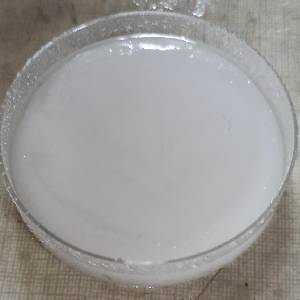 |
alginate | alginate powder 12 gr | glycerin 20 gr | ||
 |
agar agar | agar agar powder 5 gr | glycerin 10 gr | ||
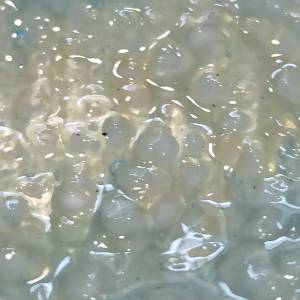 |
tapioca | manioc starch 10 gr | glycerin 5.4 gr | vinegar 5 ml | |
 |
gelatin | granulated gelatin 48 gr | glycerin 48 gr | few drops of soap |
Process and workflow¶
Alginate recipe (with calcium chloride)¶
Definition from Wikipedia. Sodium alginate is a salt extracted from this viscous liquid derived from the cell wall of brown algae. Its natural function is to increase the flexibility of the algae. Algae growing in rough waters generally have a higher alginate content than those growing in calm waters.
* 400 ml water
* 10 gr sunflower oil
* 20 gr glycerin
* 12 gr sodium alginate
* optional coloring
* Measuring cup
* Spoon
* Pot
* Bowl and pan
* Hotplate
* Measure each ingredient
* Mix together until a viscous and homogeneous texture is obtained
* Leave to rest for a few hours, until the bubbles rise
* Prepare a 10% calcium chloride solution in a spray bottle
* Pour the mixture into alginate in a mold or on a surfacedehydrate..

The preparation with alginate had already been done for a workshop with the Textile Lab for mixing with ground textile. I was able to reuse the preparation made.
One of the principles for making alginate “plastic” is to spray it with calcium chloride solution.
The effect will plasticize the membrane and thus make it waterproof when it dries.
you can also rinse the alginate to stop the action of the calcium chloride. Otherwise the chemical reaction continues to act.
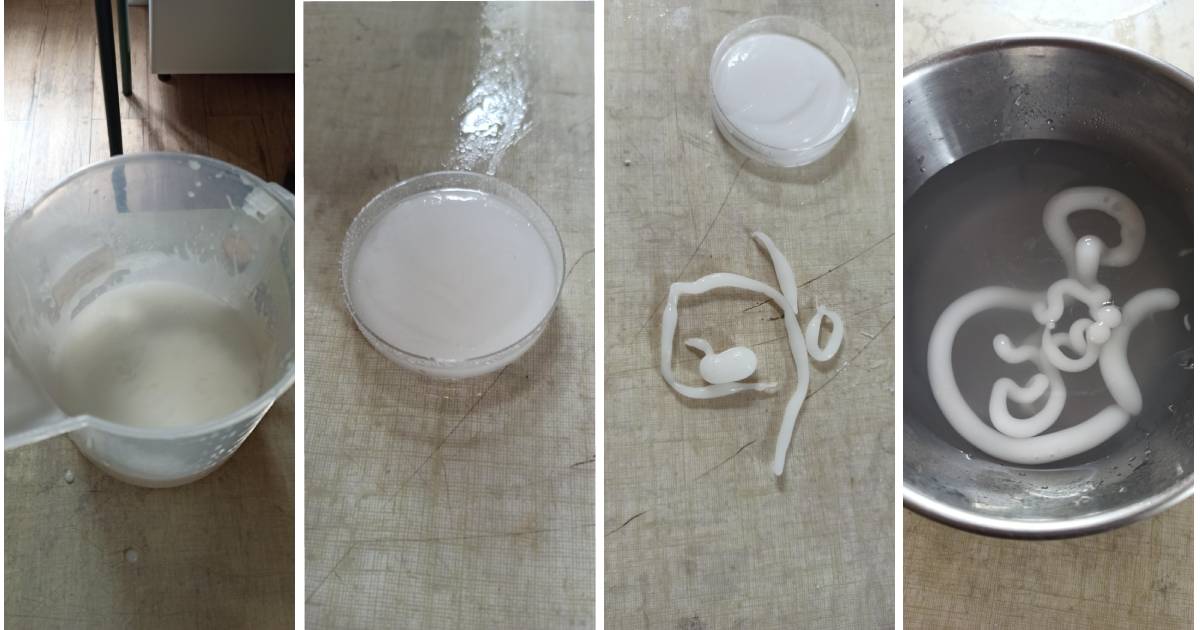 Alignate preparation | alginate petri plate test | petri plate alginate and thread test | alginate thread test
Alignate preparation | alginate petri plate test | petri plate alginate and thread test | alginate thread test
Test Alginate knitting¶
I tested another one with alginate and black iron oxyde. I wanted to knit it. Some residue remained, forming like small balls of tapioca. The texture of the thread was pleasant to knit.

Black iron oxyde and alginate | Alginate thread in water | some residue...
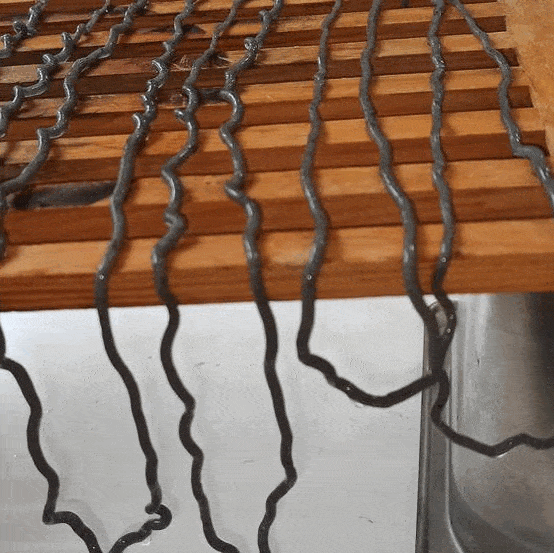
Result Alginate Knitting¶

Knitting D day | Knitting D3 | Knitting D4
Measures of the knitted piece:
- D1: width= 9cm, length=6.5cm
- D3: width= 7cm, length=4.5cm
- D4: width= 6.8cm, length=3.8cm
The thread dried after being wrapped around a knitting needle.
The texture has changed, the thread is less "elastic" and can break if you pull it too hard.
Agar agar recipe¶
Definition from Wikipedia: Agar-agar (word of Indonesian-Malay origin, referenced E406 in the list of food additives) is a gelling product [...]. It is a polymer of galactose (galactan) contained in the cell wall of certain species of red algae.
* 250 ml water
* 10 gr glycerin
* 5 gr agar agar powder
* optional coloring
* Measuring cup
* Spoon
* Pot
* Bowl and pan
* Hotplate
* Prepare your equipement
* Measure each ingredient
* Mix well in a pot,over medium heat, avoiding boiling, until the appearance is syrupy
* Transfer it on your equipment, before the mixture cools and is no longer malleable.

Rendered after drying Day 5¶
 with Petri plate, with a textured surface, with the honeycomb silicone mold (reduction from 17cm to 10cm)
with Petri plate, with a textured surface, with the honeycomb silicone mold (reduction from 17cm to 10cm)
Tapioca recipe¶
Definition from Wikipedia: Tapioca is a starch made from the roots of bitter cassava (toxic before processing), dried and then processed. Made up of starch, its taste is neutral. Regular tapioca comes in irregular grains of about 3 mm.
* 40 ml water
* 5.4 gr glycerin
* 15 gr manioc starch
* 5 ml vinegar
* optional coloring
* Measuring cup
* Spoon
* Pot
* Bowl and pan
* Hotplate
* Measure each ingredient
* Mix well in a pot,over medium heat, avoiding boiling, until the appearance is syrupy, for around 10 minutes
* Transfer it on your equipment, before the mixture cools and is no longer malleable

Test to have three different layers on the Petri plates (Thickness 1, 2, 3).
The tapioca grains remain formed in the mixture. The coloring with the blue pigment makes me think of coral and the sea.
Petri plates measurements:
- thin Petri plate: diam=9 cm, length=0.7cm
- medium Petri plate: diam=8.5cm, length=1cm
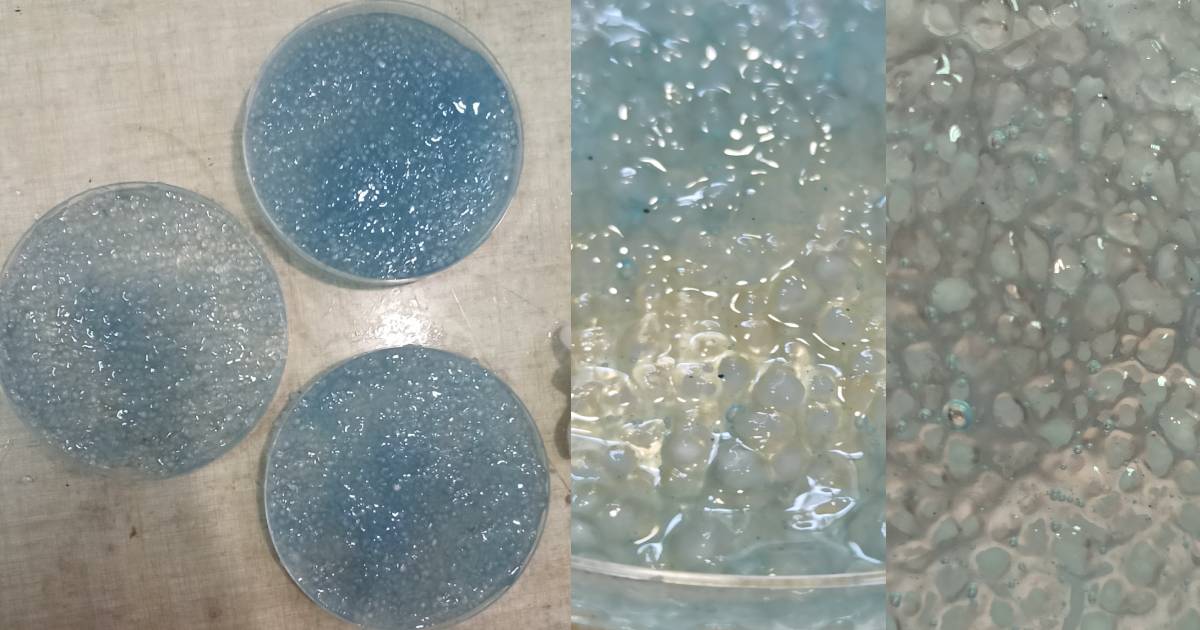
Rendered after drying Day 5¶
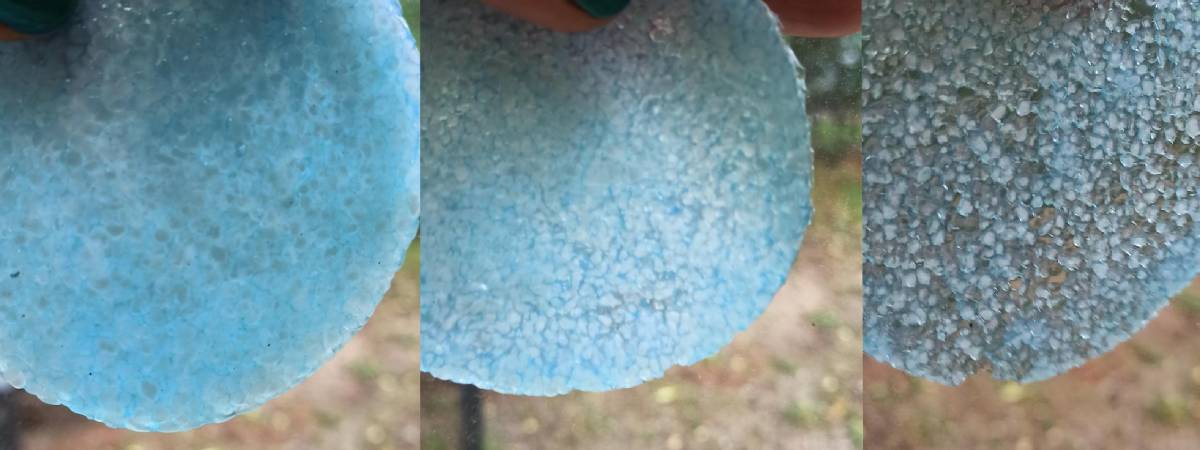 Thickness 1, 2, 3. The surface is dry but the texture is still wet
Thickness 1, 2, 3. The surface is dry but the texture is still wet
Gelatine resin recipe¶
Definiton from Wikipedia: Gelatin is a translucent, transparent or slightly yellow, almost tasteless and odorless solid substance, obtained by prolonged boiling of connective tissues (skins) or bones of animals (mainly pork, beef and fish). It has numerous applications in the culinary field, medicine, the food and pharmaceutical industries.
* 240 ml water
* 8 gr glycerin
* 48 gr gelatin
* optional coloring
* Measuring cup
* Spoon
* Pot
* Bowl and pan
* Hotplate
* Prepare your equipement
* Measure each ingredient
* Mix well in a pot,over medium heat, avoiding boiling, until the appearance is syrupy
* Transfer it on your equipment, before the mixture cools and is no longer malleable
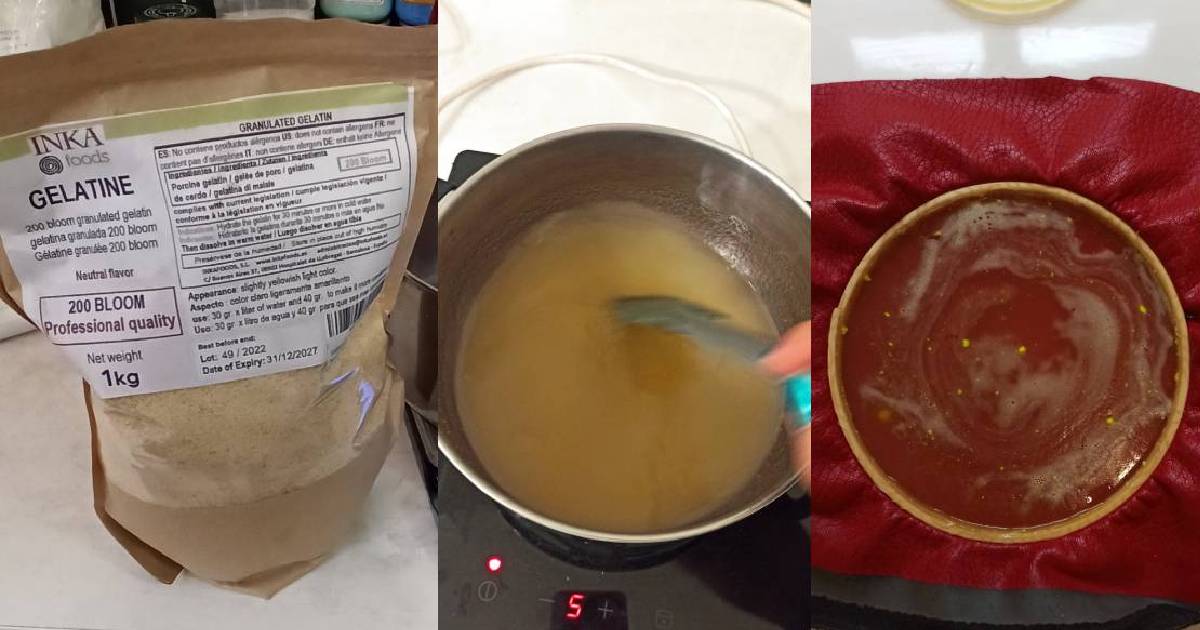
Rendered after drying Day 5¶
 With imitation leather, with a Petri plate and a textured surface
With imitation leather, with a Petri plate and a textured surface
Gelatine sheet recipe¶
* 240 ml water
* 24 gr glycerin
* 48 gr gelatin
* optional coloring
* Measuring cup
* Spoon
* Pot
* Bowl and pan
* Hotplate
* Prepare your equipement (like a flat surface)
* Measure each ingredient
* Mix well in a pot,over medium heat, avoiding boiling, until the appearance is syrupy
* Transfer it on your equipment, before the mixture cools and is no longer malleable
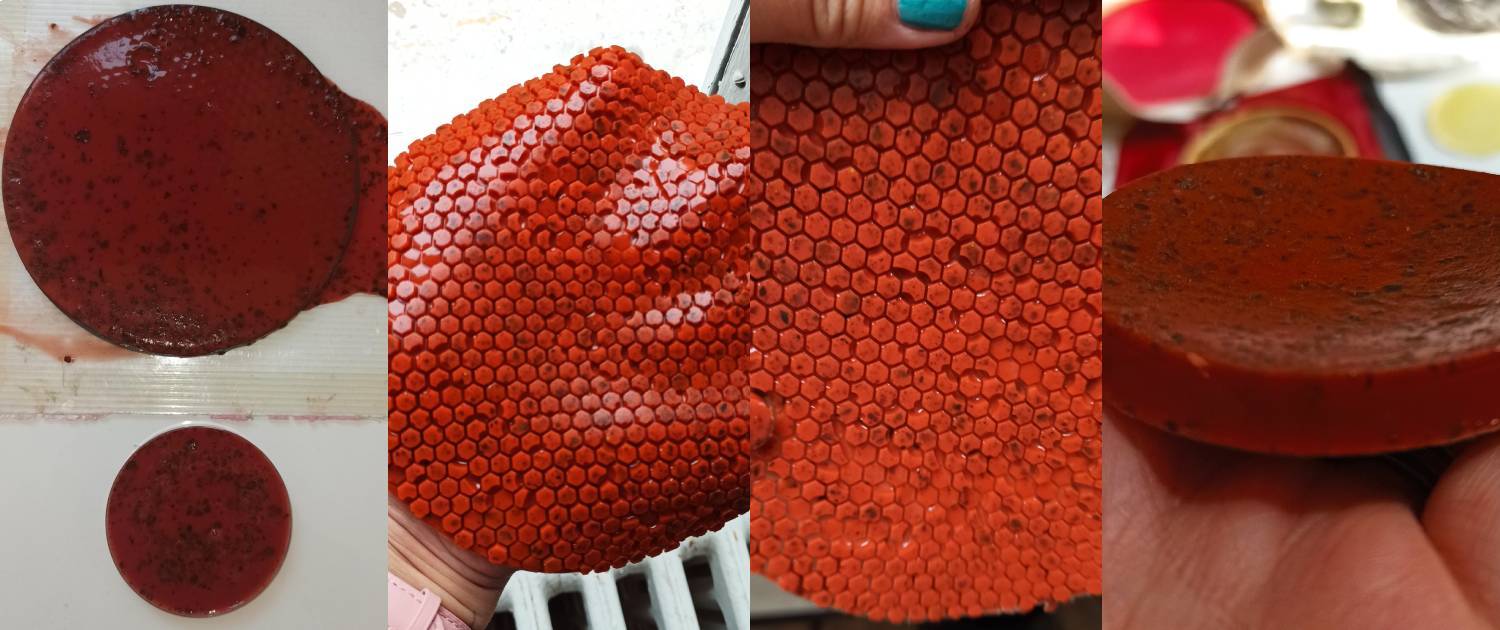
Rendered after drying Day 5¶
 with the honeycomb silicone mold and Petri plate
with the honeycomb silicone mold and Petri plate
Gelatin silicon recipe¶
* 240 ml water
* 48 gr glycerin
* 48 gr gelatin
* optional coloring
* Measuring cup
* Spoon
* Pot
* Bowl and pan
* Hotplate
* Prepare your equipement (like a flat surface)
* Measure each ingredient
* Mix well in a pot,over medium heat, avoiding boiling, until the appearance is syrupy, for around 10 minutes
* Keep half and leave to transfer it on your equipment, before the mixture cools and is no longer malleable
* Take the other half and add a few drops of soap. Whisk the mixture until frothy.
* As it dries, you can see the two layers, the heavier mix on the find and the mousse on top (like a magic cake).
Test with black iron oxyde
![]()
Test with spirulin
![]()
I retested Gelatin silicon without soap and with eggshells and gold pigment. Once the "leaf" was dried, I cut it with scissors to make the weave. The texture is still a little sticky but very malleable and elastic
![]()
Rendered after drying Day 5¶
![]()
With eggshells, with soap and spirulin, with black iron oxide on a textured surface.
Casein test¶
Definition from Wikipedia: Caseins are proteins that make up the majority of the nitrogen components of milk. The first phase of cheese making is their precipitation by adding an acid or rennet. The word casein comes from the Latin caseus, “cheese”.
Test were made by Pauline
Initial test:
- 10gr casein
- 14.5gr ash detergent
- 5.5gr glycerin
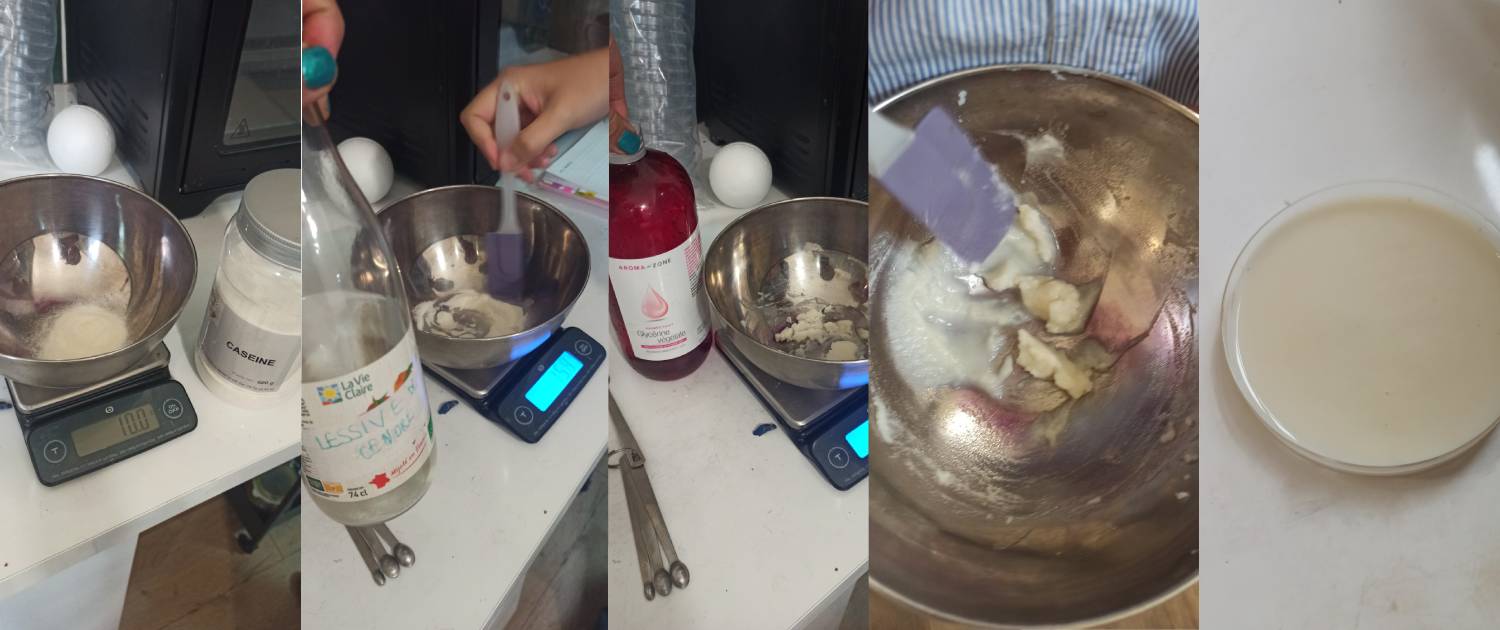
Test 1:
- 10gr casein
- 10gr glycerin
- 1 tbsp black iron oxyde
Test 2:
- 7gr of the mixture test 1
- 1gr ash detergent

To continue the work, these samples can be compared to the work of Audrey Kalic' assignementLe Textile Lab Lyon 2022-23
Rendered after drying Day 5¶
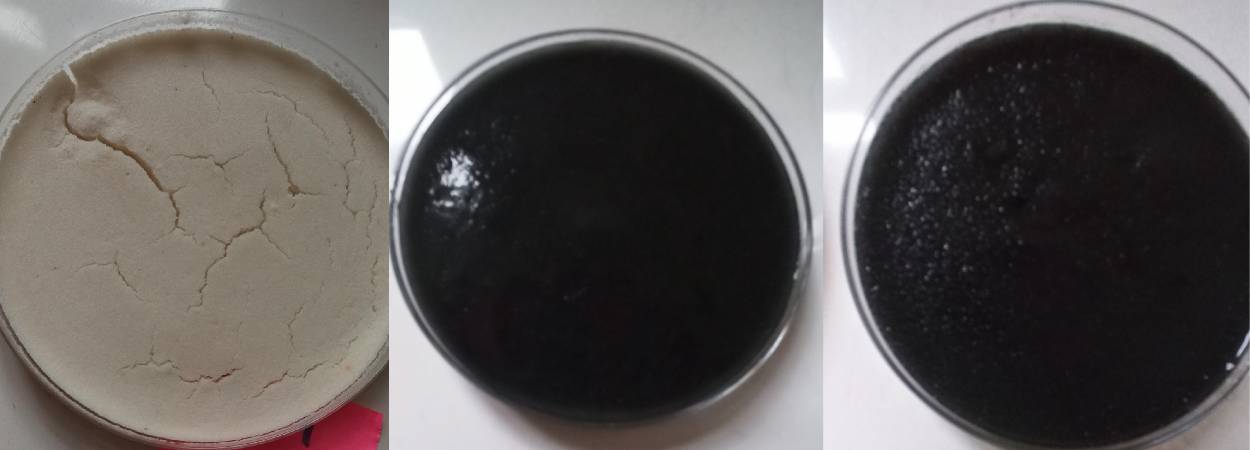 Initial test, Test 1, Test 2
Initial test, Test 1, Test 2
🗂️ Recipes¶
The Cook Book-Le Textile Lab in french
My Week06 Cookbook
The secrets of BioPlastic
Going further¶
I'd like to try making biomaterials with kombucha (to be added to this documentation🙂) and with mushroom bases.
To complete with Mycoworks
Another idea to test would be to use laser cutting on the gelatin sheets when they are completely dried in order to see the resistance and quality of the cutting; and if possible to use them in the upcoming project 🤩.
Once upon a time the (gelatin silicon soap) Moon...
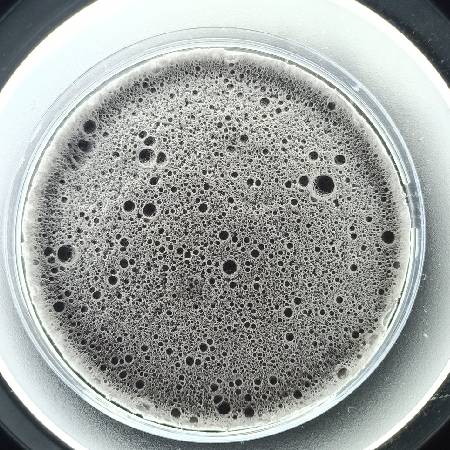
Few weeks later: Growing a material¶
I was able to try it out with the Kombucha base Diane gave me. I followed the recipe at home with black tea that I brewed with sugar.

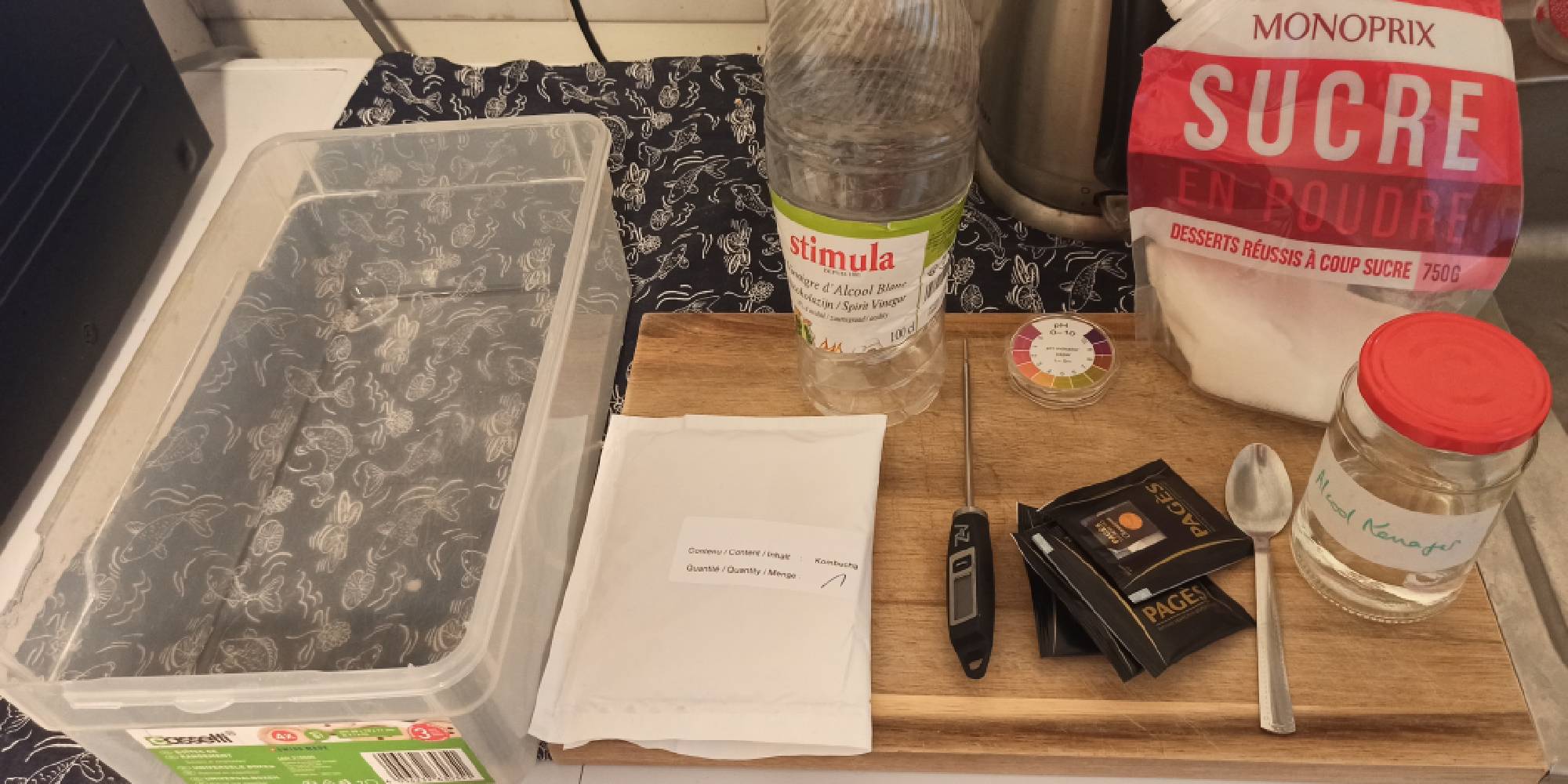
The result wasn't up to scratch and I'm a bit disappointed. The rendering of the material is not what I expected. Here are a few photos of my test.
I regularly checked the temperature to make sure it was close to 30°, so that I could put the mother Kombucha into the preparation. Then I had to check the PH and adjust it with the vinegar to obtain a value between 2 and 3.

I then decanted the mixture into a container that had been disinfected with rubbing alcohol to remove any traces of bacteria or germs. Then I covered it with a clean coton cloth. I left the kombucha in a corner of my bathroom (the "warmest" room in the house), but it wasn't getting any bigger. So I switched places in a corner of my kitchen and it became "thicker".

After a month and a half, the kombucha had thickened. By the following week, it had dried out. I should have added more water and/or vinegar to continue feeding it, but I had my doubts about the result.

The kombucha was fragile, the texture rather slimy. I washed it and put it to dry, but the leaf cracked in several places and was very thin (like cigarette paper). I'll have to do it again, and keep a closer eye on the evolution of the material.
